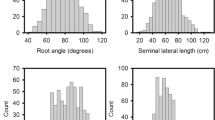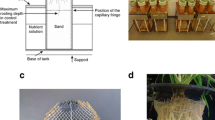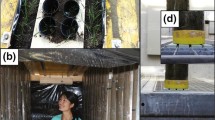Abstract
Background and aims
The role of the root system in mediating crop yields has recently been emphasised, resulting in several laboratory approaches for phenotyping root traits. We aimed to determine the existence of, and reasons for, genotypic variation in wheat (Triticum aestivum L.) root penetration of strong wax layers.
Methods
Three contrasting groups (UK elite lines, CIMMYT lines and near-isogenic lines of cv Mercia containing dwarfing and semi-dwarfing Rht alleles) comprising 18 different genotypes with contrasting phenologies were studied. We determined the ability of roots of these genotypes to penetrate strong wax layers and the angular spread of the root systems.
Results
There were no intrinsic differences in root system ability to penetrate strong wax layers (consistent with the similar root diameter of all lines) since greater root penetration was simply related to more root axes. Recording root penetration of concentric zones of the wax layer demonstrated that cv. Battalion had a root system with a smaller angular spread than cv. Robigus, which had the root system with the greatest angular spread.
Conclusions
There was limited genotypic variability in root penetration of strong layers within the wheat cultivars studied. A key challenge will be to determine the physiological and agronomic significance of the variation in root angular spread.



Similar content being viewed by others
References
Bengough AG, Gordon DC, Al-Menaie H, Ellis RP, Allan D, Keith R, Thomas WTB, Forster BP (2004) Gel observation chamber for rapid screening of root traits in cereal seedlings. Plant Soil 262:63–70
Botwright Acuna TL, Pasuquin E, Wade LJ (2007) Genotypic differences in root penetration ability of wheat through thin wax layers in contrasting water regimes and in the field. Plant Soil 301:135–149
Clark LJ, Aphalé SL, Barraclough PB (2000) Screening the ability of rice roots to overcome the mechanical impedance of wax layers: importance of test conditions and measurement criteria. Plant Soil 219:187–196
Clark LJ, Cope RE, Whalley WR, Barraclough PB, Wade LJ (2002) Root penetration of strong soil in rainfed lowland rice: comparison of laboratory screens with field performance. Field Crop Res 76:189–198
Clark LJ, Ferraris S, Price AH, Whalley WR (2008a) A gradual rather than abrupt increase in strength gives better root penetration of strong layers. Plant Soil 307:235–242
Clark LJ, Price AH, Steele KA, Whalley WR (2008b) Evidence from near-isogenic lines that root penetration increases with root diameter and bending stiffness in rice. Funct Plant Biol 35:1163–1171
Ghanem ME, Hichri I, Smigocki AC, Albacete A, Fauconnier ML, Diatloff E, Martínez-Andújar C, Lutts S, Dodd IC, Pérez-Alfocea F (2011) Root-targeted hormonal biotechnology to improve crop stress tolerance. Plant Cell Rep 30:807–823
Gregory PJ, Bengough AG, Grinev D, Schmit S, Thomas WTB, Wojciechowski T, Young IM (2009) Root phenomics of crops: opportunities and challenges. Funct Plant Biol 36:922–929
Hargreaves CE, Gregory PJ, Bengough AG (2009) Measuring root traits in barley (Hordeum vulgate ssp. Vulgare and ssp. Spontaneum) seedlings using gel chambers, soil sacs and x-ray microtomography. Plant Soil 316:285–297
Kubo K, Jitsumyama Y, Iwaman K, Hasegawa T, Watanabe N (2004) Genotypic differences in root penetration ability by durum wheat (Tricticum turgidium L. var. durum) evaluated by a pot with paraffin-Vaselin discs. Plant Soil 262:169–177
Kubo K, Iwama K, Yanagisawa A, Watananbe Y, Terauchi T, Jitsuyama Y, Miuma T (2006) Genotypic variation in the ability of root to penetrate hard soil layers amoung Japanese wheat cultivars. Plant Prod Sci 9:47–57
Li QQ, Dong BD, Qiao YZ, Liu MY, Zhang JW (2010) Root growth, available soil water, and water-use efficiency of winter wheat under different irrigation regimes applied at different growth stages in North China. Agr Water Manag 97:1676–1682
Lopes MS, Reynolds MP (2010) Partitioning of assimilates to deeper roots is associated with cooler canopies and increased yield under drought in wheat. Funct Plant Biol 37:147–156
Lynch JP (2007) Roots of the second Green Revolution. Aust J Bot 55:493–512
Lynch JP (2011) Root phenes for enhanced soil exploration and phosphorous acquisition: tools for future crops. Plant Physiol 156:1041–1049
Materechera SA, Dexter AR, Alston AM (1991) Penetration of very strong soils by seedling roots of different plant species. Plant Soil 135:31–41
Manschadi AM, Christopher J, deVoil P, Hammer GL (2006) The role of root architectural traits in adaptation of wheat to water-limited environments. Funct Plant Biol 33:823–837
Manschadi AM, Hammer GL, Christopher JT, deVoil P (2008) Genotypic variation in seedling root architectural traits and implications for drought adaptation. Plant Soil 303:115–129
Martin Vertedor AI, Dodd IC (2011) Root-to-shoot signalling when soil moisture is heterogeneous: increasing the proportion of root biomass in drying soil inhibits leaf growth and increases leaf ABA concentration. Plant Cell Environ 34:1164–1175
McKenzie BM, Bengough AG, Hallett PD, Thomas WTB, Forster B, McNicol JW (2009) Deep rooting and drought screening of cereal crops: a novel field-based method and its application. Field Crop Res 112:165–171
Norton GJ, Aitkenhead MJ, Khowaja FS, Whalley WR, Price AH (2008) A bioinformatic and transcriptomic approach to identifying positional candidate genes without fine mapping; an example for rice root growth QTLs. Genomics 92:344–352
Qin PR, Stamp P, Richner W (2004) Impact of tillage on root systems of winter wheat. Agron J 96:1523–1530
Trachsel S, Kaeppler SM, Brown KM, Lynch JP (2011) Shovelomics: high throughput phenotyping of maize (Zea mays L.) root architecture in the field. Plant Soil 341:75–87
Whalley WR, Clark LJ, Finch-Savage WE, Cope RE (2004) The impact of mechanical impedance on the emergence of carrot and onion seedlings. Plant Soil 265:315–323
Whalley WR, Clark LJ, Gowing DJG, Cope RE, Lodge RJ, Leeds-Harrison PB (2006) Does soil strength play a role in wheat yield losses caused by soil drying? Plant Soil 280:279–290
Whalley WR, Watts CW, Gregory AS, Mooney SJ, Clark LJ, Whitmore AP (2008) Effect of soil drying on the yield of wheat grown on shrinking and non-shrinking soil. Plant Soil 306:237–247
White RG, Kirkegaard JA (2010) The distribution and abundance of wheat roots in a dense, structured subsoil—implications for water uptake Plant. Cell Environ 33:133–148
Whiteley GM, Hewitt JS, Dexter AR (1982) The buckling of plant roots. Physiol Plant 54:333–342
Wojciechowski T, Gooding MJ, Ramsay L, Gregory PJ (2009) The effects of dwarfing genes on seedling root growth of wheat. J Exp Bot 60:2565–2573
Acknowledgements
We thank the UK Department for Environment Food and Rural Affairs (Defra - Project WU0121) and the Biotechnology and Biological Sciences Research Council (BBSRC -BB/E006922) for supporting this work. We thank Professor John Snape (JIC, Norwich, UK) for providing the Rht lines used in this work and to CIMMYT for providing additional genotypes.
Author information
Authors and Affiliations
Corresponding author
Additional information
Responsible Editor: Peter J. Gregory.
Rights and permissions
About this article
Cite this article
Whalley, W.R., Dodd, I.C., Watts, C.W. et al. Genotypic variation in the ability of wheat roots to penetrate wax layers. Plant Soil 364, 171–179 (2013). https://doi.org/10.1007/s11104-012-1342-0
Received:
Accepted:
Published:
Issue Date:
DOI: https://doi.org/10.1007/s11104-012-1342-0




